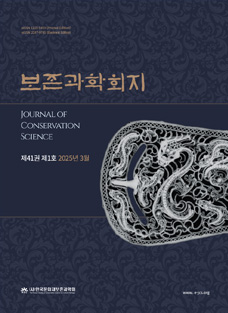Journal of Conservation Science Vol.28 No.1 pp.39-52
일본 오이타현 우스키 마애불상군의 재질특성 및 손상도 평가
조지현,이찬희,김지영,마사유키 모리,이명성,김사덕
Deterioration Evaluation and Material Characteristics of the Usuki Stone Buddha Statues in Oita, Japan
Ji Hyun Cho,Chan Hee Lee,Jiyoung Kim,Masayuki Morii,Myeong Seong Lee,Sa Dug Kim
Abstract
The Usuki Stone Buddha Statues in Oita are consisted of 60 Buddhas which represent of Japan carved on the rock-cliff in the 12 to 14th centuries. The basement rock of the statues is dark gray welded lapilli tuff that containing the Aso-4 pyroclastic rock group. Deterioration maps for the Hoki Ⅰ and the Furuzono Buddha Statues group show multi-directional fissures on the Cakra, and sheeting-off zone at the margin of uprising water. Deterioration rate of the Hoki Ⅰ group was calculated fissure about 121 in number, 19% of sheeting-off zone and 51% of biological weathering in surface of area. And the Furuzono group was also evaluated as about 48 of fissures in number, 24% of sheeting-off zone and 41% biological weathering. The slope stability assessment results, the Hoki Ⅰ developed discontinuous planes has possibility of planar, toppling and wedge failures in all caves. Ultrasonic velocity of the Aizen-myooh (basement rock) ranges from 1,520 to 2,794 (average 2,298㎧). And pedestal of Amita-yeorae which has been replaced by new fresh rock is measured as 3,242 to 4,141 (average 3,813㎧). Therefore, we establish of planing conservation treatment and reinforcement methods to fissure, cavity, sheeting-off zone in the Buddha surface.

 E-Submission
E-Submission 
 E-Submission
E-Submission 
![]() Journal Search Engine
Journal Search Engine




 KSC
KSC